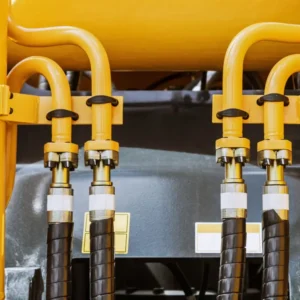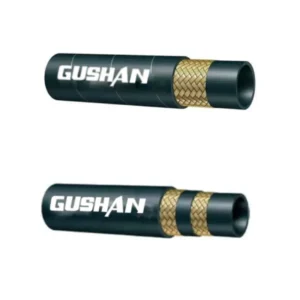Hydraulic hoses are critical components in many industrial and mechanical systems. However, like any mechanical part, they have a limited lifespan. Understanding when to replace hydraulic hoses is crucial to prevent accidents, downtime, and costly repairs.
In the following sections, we’ll delve deeper into the factors influencing hose lifespan and the signs indicating it’s time for replacement.
How Often Should You Replace Hydraulic Hoses
The lifespan of a hydraulic hose can vary depending on several factors, including operating conditions, maintenance, and the quality of the hose itself. However, a general guideline is to replace hydraulic hoses every 2-5 years.
Key Factors Influencing Lifespan:
- Operating Conditions:
- Temperature: Extreme temperatures, both high and low, can accelerate hose degradation.
- Pressure: High-pressure applications can stress the hose material.
- Vibration: Constant vibration can cause fatigue and wear.
- Chemical Exposure: Exposure to chemicals can deteriorate the hose material.
- Maintenance:
- Regular Inspection: Frequent visual inspections can help identify signs of wear, such as cracks, cuts, or leaks.
- Proper Installation: Correct installation can prevent premature failure due to kinking or excessive stress.
- Avoidance of Extreme Conditions: Protecting hoses from extreme temperatures, excessive vibration, and harmful chemicals can prolong their life.
Signs of Wear and Tear:
- Visible Damage: Cracks, cuts, or abrasions on the hose surface.
- Fluid Leaks: Any leakage of hydraulic fluid indicates a problem.
- Kinks or Bends: These can restrict fluid flow and damage the hose.
- Discoloration or Stiffening: Changes in the hose’s appearance or flexibility.
Remember, replacing a hydraulic hose before it fails completely can prevent costly repairs and downtime. Regular inspections and preventive maintenance are crucial to ensure the safety and reliability of your hydraulic system.
If you notice any of these signs of wear or damage, or if your hoses are nearing the end of their expected lifespan, it’s advisable to replace them promptly. Consulting with a hydraulic expert can help you assess the condition of your hoses and determine the optimal replacement schedule.
How Many Years Do Hydraulic Hoses Last
The hydraulic hose shelf life can vary significantly depending on several factors, including:
- Operating Conditions: Factors like temperature, pressure, vibration, and exposure to chemicals can significantly impact the hose’s lifespan.
- Maintenance: Regular inspection and replacement of worn hoses can extend their life.
- Hose Material and Type: Different materials and types of hoses have varying lifespans.
Generally, hydraulic hoses can last between 5 to 10 years under normal operating conditions. However, it’s important to note that this is just an estimate, and the actual lifespan can be shorter or longer.
To maximize the lifespan of your hydraulic hoses, consider the following:
- Regular Inspection: Conduct regular visual inspections for signs of wear, such as cracks, cuts, or leaks.
- Proper Installation: Ensure hoses are installed correctly to avoid kinking or excessive stress.
- Avoid Extreme Conditions: Protect hoses from extreme temperatures, excessive vibration, and exposure to harmful chemicals.
- Replace Worn Hoses Promptly: Replace any damaged or worn hoses immediately to prevent accidents and downtime.
By following these guidelines, you can significantly extend the life of your hydraulic hoses and ensure the smooth operation of your equipment.
Hydraulic Hose Replacement Cost
The cost to replace a hydraulic hose can vary significantly depending on several factors, including:
- Hose length and diameter: Longer and larger diameter hoses typically cost more.
- Hose material and type: The specific material and type of hose (e.g., rubber, wire braid, or thermoplastic) will influence the price.
- Fittings and adapters: The type and complexity of the fittings and adapters required can impact the cost.
- Labor costs: The labor cost will vary depending on the mechanic’s hourly rate and the complexity of the job.
- Vehicle make and model: Different vehicles have different hose lengths, fittings, and installation complexities.
Generally, the cost to replace a hydraulic hose, including parts and labor, can range from $20 to $300 or more. However, it’s important to note that this is just an estimate, and the actual cost may be higher or lower depending on specific factors.
To get an accurate estimate for your specific vehicle, it’s best to consult with a local mechanic or auto repair shop. They can provide you with a precise quote based on your vehicle’s make and model, as well as any additional services required, such as bleeding the clutch system.
DIY Replacement:
For those who are mechanically inclined, it’s possible to replace a hydraulic clutch hose yourself. This can save on labor costs, but it requires specific tools and knowledge. It’s important to consult your vehicle’s service manual or a repair guide to ensure proper installation and bleeding of the clutch system.
Remember, a properly functioning clutch hose is essential for safe and efficient driving. If you notice any signs of a failing clutch hose, such as fluid leaks, difficulty shifting gears, or a spongy clutch pedal, it’s important to have it replaced promptly.
Hydraulic Hose Replacement Procedure
Here’s a step-by-step guide on how to replace a hydraulic hose:
1. Safety First:
- Wear protective gear: Always wear safety glasses, gloves, and protective clothing to protect yourself from potential injuries.
- Release system pressure: Ensure the hydraulic system is completely depressurized before starting the replacement process. This can usually be done by releasing pressure valves or using a pressure relief valve.
2. Drain the System:
- Isolate the Section: If possible, isolate the section of the hydraulic system where the hose is located to minimize fluid loss.
- Drain the Fluid: Use a drain pan or container to collect the hydraulic fluid. Dispose of it properly according to local regulations.
3. Disconnect the Old Hose:
- Locate the Hose: Identify the hose to be replaced.
- Release Fittings: Carefully loosen and remove the fittings from both ends of the old hose.
- Clean the Fittings: Clean the fittings and mating surfaces to ensure a clean connection for the new hose.
4. Measure and Cut the New Hose:
- Measure the Old Hose: Accurately measure the length of the old hose, including any bends or curves.
- Cut the New Hose: Use a hydraulic hose cutter to cut the new hose to the exact length, ensuring a clean and precise cut.
5. Prepare the Hose Ends:
- Skiving or Flaring: Depending on the type of fittings, prepare the hose ends by skiving or flaring them to create a specific profile for a secure connection.
- Clean the Hose Ends: Clean the prepared hose ends to remove any debris or contaminants.
6. Attach the Fittings:
- Insert the Hose: Insert the prepared hose ends into the fittings.
- Crimp the Fittings: Use a hydraulic hose crimping tool to crimp the fittings onto the hose, ensuring a secure and leak-proof connection. Follow the manufacturer‘s instructions for the specific crimping procedure.
- Tighten the Fittings: Tighten the fittings to the manufacturer‘s specified torque.
7. Install the New Hose:
- Route the Hose: Carefully route the new hose, avoiding sharp bends, excessive twists, and contact with hot surfaces.
- Secure the Hose: Use clamps or other methods to secure the hose in place, preventing movement and potential damage.
- Connect the Fittings: Connect the fittings to the hydraulic system components, ensuring a tight fit.
8. Bleed the System:
- Cycle the System: Operate the hydraulic system to circulate the fluid and remove air bubbles.
- Use a Bleeder Valve: If equipped, use a bleeder valve to release air from specific points in the system.
- Check for Air Pockets: Monitor the system for any signs of air pockets, such as noisy operation or sluggish performance.
9. Test for Leaks:
- Visual Inspection: Visually inspect all connections for leaks.
- Leak Detection Fluid: Apply a leak detection solution to the fittings and connections to identify any leaks.
- Pressure Test: If possible, pressure test the system to ensure there are no leaks.
10. Final Inspection:
- Double-Check Connections: Ensure all connections are tight and secure.
- Verify System Operation: Test the hydraulic system to ensure it is functioning correctly.
Remember, if you’re unsure about any step or encounter difficulties, seek professional help.
Conclusion
By understanding the factors affecting hydraulic hose lifespan and recognizing the signs of wear, you can make informed decisions about replacement. Regular inspections, proper maintenance, and timely replacements are essential to ensure the safety and reliability of your hydraulic systems.
Need high-quality hydraulic hoses for your next project?
Gushan Rubber offers a wide range of durable and reliable hydraulic hoses to meet your specific needs. Our hoses are designed to withstand demanding conditions and provide optimal performance.
Contact us today to explore our bulk purchasing options and get the best deal on high-quality hydraulic hoses.



